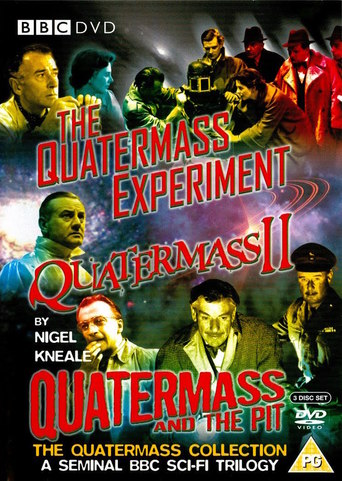

The Quatermass Collection (1955)
Originally broadcast by the BBC in 1995 in six parts, each lasting 30 minutes. The serial sees Professor Bernard Quatermass of the British Experimental Rocket Group being asked to examine strange meteorite showers. His investigations lead to his uncovering a conspiracy involving alien infiltration at the highest levels of the British Government. As even some of Quatermass's closest colleagues fall victim to the alien influence, he is forced to use his own unsafe rocket prototype, which recently caused a nuclear disaster at an Australian testing range, to prevent the aliens from taking over mankind.
Watch Trailer
Cast


Reviews
Memorable, crazy movie
A Masterpiece!
Although it has its amusing moments, in eneral the plot does not convince.
When a movie has you begging for it to end not even half way through it's pure crap. We've all seen this movie and this characters millions of times, nothing new in it. Don't waste your time.
Every generation thinks they invented everything themselves and that everything under the sun is new; for myself I find it easy to believe that mistrust of Government, alien conspiracy and the like are all themes which came into sci-fi with the X-Files, and that in the 1950's it was all thinly veiled Communist allegory and nothing else. Quatermass is proof that this idea is of course nonsense. I have seen the film versions but fellow IMDb user Theo Robertson kindly lent me his DVD of the original series so that I can find out about it for myself. The first season offered potential but unfortunately only a couple of episodes existed, but it was enough to make me keen to watch the second season (all of which remains).As before this was broadcast live – amazing to someone like me who is used to such a thing being a "special" event a la ER or 30 Rock doing it. Using some recorded external shots, the show is impressive for being live – the odd flubbed word but no break in reality and no visible problems (although the inability to precisely hit the 30 minute mark must have been a big headache of the BBC at the time). Although the majority of the show is therefore shot on sound stages and limited in regards movement, it doesn't feel like it is because the delivery is so very atmospheric and the tone so very engaging. The very proper 1950's BBC warning about viewer discretion may be a period curio that is amusing now, but one can imagine the impact of this show in this world of sedate and family-friendly programming. The build within the show is mostly strong – from the very early episodes through to the bigger Governmental conspiracy it is mostly all very well done because it remains within the real world and takes real world suspicious and flips them within sci-fi. The lack of trust for Government and for large businesses is all here and it is very well done.Such a shame then that the last episode blows it completely by taking it from this into the realm of fantasy. Heading into this episode I had assumed that the rocket would be used as a missile to destroy the aliens high above earth; when Leo got infected I assumed that the rocket would need a pilot and that he would sacrifice himself in a good ending. While not great ideas, these are better than what we got which was a manned rocket mission which ends with Quatermass returning. It is a poor ending to an otherwise strong run of episodes and it did feel like the season could easily have done without it. Not sure what the fans feel (I may have just committed blasphemy here) but for me it was excessive, a bit silly and went against the tension and drama that had been so consistent up till that point.The cast are different from the previous season – in particular we have a new Quatermass in the form of Robinson. His voice took me a minute to get used to because at times he sounded like he was acting in a theatre rather than TV, but quickly he is natural and good – able to deliver complex dialogue but yet make it dramatic and urgent. He is reasonably well supported by those around him but Grey is a massive problem as his daughter. It is not that she is bad, it is just that she seems to have been almost too "trained" – while others are acting, she is Acting. She speaks very clearly, her dialogue is as crisp as the finest BBC announcer and it would not have surprised me if she had delivered some of her scenes with three books balanced on her head to show how good her posture was; every time she is on screen she is unnatural and rather disruptive – fortunately she is not on too much. Speaking of stiff, the performances of the infected don't really work either as they are just a bit too obviously wrong. This is not a massive problem when we have them as guards, but when they are in parliament I would have liked them to have been a bit more subtle. I remember as a child laughing myself silly at the idea that the aliens in V were easily spotted by not being able to wave without their fingers sticking together in a certain way, here it is almost as obvious – not a massive problem again, but it meant the "menace" that Quatermass describes feeling isn't really as creeping or as hidden as I would have liked.Overall though, this is a very impressive piece of sci-fi. Technically the live broadcast is all the more impressive for the fact that it isn't obviously live but it is the writing and delivery that makes it work. Feeding on themes of conspiracy and paranoia, the plot develops at a good pace and builds menace and tension throughout – it is only some wobbly moments and a really weak final episode that let it down. Well worth seeing – this is almost 50 years old but (production values and effects aside) still feels fresh and relevant.
I recently watched this TV serial back-to-back with the Hammer movie version.It was originally broadcast live, but was recorded off monitors using two different systems. One system only recorded alternate scan lines so the image is often of very low resolution. The recording is also marred by light leakage. In one episode there was clearly a fault with one of the TV cameras. As a result, the image quality is highly variable, but is still good enough for an evaluation of this early TV classic.It inevitably suffers from the limitations of live broadcasting, but also looks under-rehearsed. Actors are noticeably missing their marks, fluffing their lines, jumping their cues and freezing into 'meaningful' close-ups before the camera is ready for them. Quatermass and the Pit was also broadcast live but is a much slicker production all round.It was probably too ambitious for its paltry budget. Even without the cost of the BBC contract staff, $20,000 was an impossibly small sum for a three hour drama. In retrospect, the final episode, set in space, was probably a mistake. The asteroid set was just tarpaulins thrown over studio junk - and that is exactly what it looks like. Although the Hammer movie was shot on a tight budget and was only half as long, it still cost ten times as much.All this can be taken for granted. The real issue is which version tells the story best.Of course, they were made for different media, so told the story in a different way. The TV version was structured to gradually draw the audience into an increasingly paranoid world, week by week, building steadily towards its climax. The movie had to grab them immediately and lead them from plot point to plot point as efficiently as possible.This serial was a distinct improvement on The Quatermass Experiment. It had a tighter, more plausible story, more action, less padding and built to a more satisfying climax. But there was room for improvement.It shows signs of having been written very quickly and could have done with a re-write. When Kneale was hired to write the movie version it was an opportunity to rethink aspects of the story. His overlong screenplay was then trimmed by Jimmy Sangster and Val Guest, who brought a fresh eye to the story and introduced further improvements. A comparison of the two versions demonstrates the advantages of this script development process. I give a few examples.In the movie, the problems with the atomic rocket are established with a just couple of lines of dialogue.In the TV version, this takes two complete scenes. Quatermass is checking his rocket because he has heard the sister rocket in Australia has gone into nuclear melt-down. This is then reinforced by a scene where he views footage of the Austalian disaster. However, to allow Robinson time for his costume change, this second scene starts with Paula Quatermass and Pugh discussing the set-back. When Quatermass appears, the scene then simply repeats information we have now already heard twice.In the movie, Quatermass is introduced to Vincent Broadhead, an MP who is already suspicious about the Winnerton Flats project. He gets Quatermass into the food plant, sneaks off to investigate one of the domes and falls into the corrosive 'food'.In the TV version, he merely gets Quatermass into a meeting of the investigation committee. He is then possessed by an alien. This means another character has to be introduced to get Quatermass into the plant and it is he who falls into the food. But he is just a PR man. Why would he go snooping around? The movie version is both more efficient and more plausible.On TV, Quatermass takes a reporter to the workers' village where he gets infected by an alien. Guards turn up to investigate the 'overshot'. Now convinced Quatermass is right, the reporter phones in his story. Spooked by what he says, the workers march on the plant.In the movie, it is someone else who gets infected. The guards turn up while the reporter is telephoning his paper and shoot him. This provides much better motivation for the workers' subsequent attack on the plant.On TV, we first see a farmer possessed by the aliens, then Dillon, a little girl, Broadhead, a Minister, the reporter and, finally, Pugh. These multiple possessions contribute to the growing paranoia, but are mostly irrelevant to the plot.The movie combines the roles of Dillon and Pugh into a single character (Marsh) and omits most of other possessions. They are not really missed.On TV, we have two climaxes: the destruction of the pressure dome, followed by the destruction of the asteroid in the next episode. The movie combines them, inter-cutting between the rocket base and the siege of the control room. The puncturing of the dome releases the aliens and the destruction of the asteroid kills them, making for a neater and more striking conclusion.Overall, therefore, the TV version has the advantage of a more measured build-up of tension and can include plot details I regret were not in the movie, but is more diffuse, more obviously padded and less well plotted. The movie is arguably a bit too efficient, but in the final analysis, it is not only better made, it is better written too.However, I am delighted this TV version is finally available for viewing. It is long overdue. 15 years ago I learnt from a TV programme that it had survived intact and wrote urging the BBC to release it on video. At long last they have.Now, my only regret is that we will never see if Neale's more expansive screenplay for Hammer might have produced an even better movie.
I could never get totally comfortable with a Quatermass who looks like and spoke like an American gangster. In spite of Brian Donlevy's fine acting skills, I thought he was totally mis-cast in this early sci-fi techno thriller. His gruffness, rudeness, and curtness, especially to women, especially date this story and get downright annoying at times. And his diction hardly creates the illusion of a top level scientist. He says things like "What's dat?" and "Both aya" (for "Both of you").It's the story that carries the movie, and a great story it is. "Meteorites" that are actually carriers of alien germination cells rain down on earth. Once a human gets too close, a meteor bursts open with a jet of ammonia gas and shoots a tiny stinger or spore into the intended carrier. Thus, humans are taken over as hosts to these aliens. Quatermass is pulled into the government conspiracy to hide the beach head "factory" of the alien invasion force when his subordinates spot the unusual series of meteor showers and his own assistant is spirited away by guards of the mysterious plant.Less is definitely more in this story. Granted, the scene where a man, coated with the pitch- like "food" manufactured at the forbidden factory, dies in agony in front of Quatermass is horrifying, even now. Otherwise, the suggestion is more powerful than the special effects. As people are taken over, and Quatermass's search for his missing assistant is thwarted again and again, the tension builds. The "tour" of the plant builds to near terror. But after that, as the viewer actually sees what Quatermass is talking about, the story becomes a lot less powerful. BBC special effects diminished the impact. As any Doctor Who fan can tell you, what the story places in your mind is far superior to what it actually depicted.The enemy forces blocking the pipe with "human pulp" struck me as absurd. And an untested atomic rocket in the backyard of the research HQ was another impossible device in the plot. Ultimately, the story reached for one horror too many, and was further undercut by the especially poor special effects at the end.That being said, it was terrific Sci-Fi for 1955, imaginative, technological, and filmed locally to enhance a "this is now" feel to the horror.For Doctor Who fans, the similarities to SPEAHEAD FROM SPACE and INFERNO are unmistakable. Some of the long shots of the plant look like shots from INFERNO (and, much later, from THE HAND OF FEAR). Another Doctor Who tie-in is the presence of Roger Delgado (the Master, from Doctor Who) as Conrad, though I never was able to spot Conrad in the film. (However, Delgado shows up in the credits, so he's got to be in there somewhere.)It's apparent that the first season of the Third Doctor era borrowed heavily from Quatermass. I'd recommend that hard-core Whovians drop the pence to buy this two-DVD set. You'll enjoy the stories and will be entertained by trying to tie in the plot lines to Third Doc/Liz Shaw era stories. The DVD Double Feature (Quatermass and the Pit and Quatermass 2) are sold by Anchor Bay.
Having recently come by a pirated copy of this on VCR recently, I can honestly say after several viewings that this has to be the best of the Quatermass seriels made by the BBC in the 1950s. Broadcast live on UK TV in 1955, this is an altogether more together piece than the remade Hammer film of a few years later and has a much more involving plot. One of the main diferences in the story has Professor Quatermass actually travel to the alien asteroid with his assistant Leo Pugh to destroy the ammonid things before more of them reach the earth.Another plot addition is the introduction of little metallic cases to contain the aliens in and make them more readily available for transportation to one victim to another, a side plot sadly missing from the afformentioned Hammer film. The story is slow to build up, but once it gets going there is no stopping it and you soon become deeply involved in the plot. The character Broadhead from the film version is called Ward here and it is only a 3 man expedition that enters the Synthetic Food plant at Winnerden Flats, during this visit Ward dies covered in black slime and Quatermass and a character called Fowler discover to their horror that a nearby picnicking family have been gunned down by the impossing Zombie guards. Altogether a fantastic serial in all 6 parts (complete for those that are still hanging onto the belief that all or some of the episodes are missing). News is doing the rounds that the serial may be making it's way onto DVD this year and hopefully it will make it.


